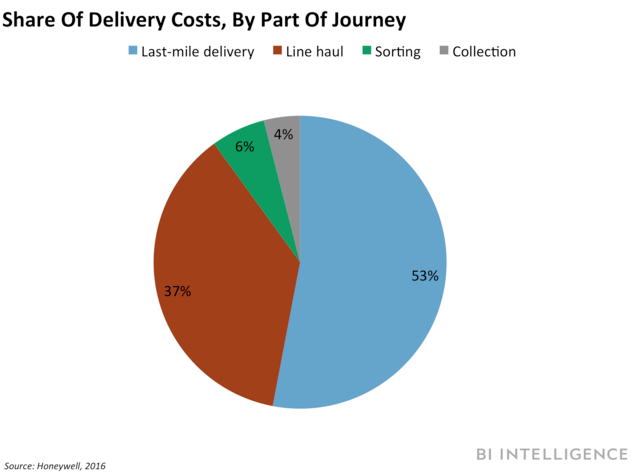This French logistics giant is going to start using drones in warehouses

BI Intelligence
This story was delivered to BI Intelligence Transportation and Logistics Briefing subscribers hours before it appeared on Business Insider. To be the first to know, please click here.
Geodis, the logistics arm of France's state-owned railroad company SNCF Group, plans to start using drones to scan its warehouses for inventory as part of a new automated inventory management system by the end of this year, according to Air Cargo News.
The company developed and will operate the drones in partnership with Delta Drone, one of France's leading drone hardware and service providers. The system they developed uses ground-based robots that receive orders from a central operator, which directs the drones to pick up inventory and bring it to be shipped out of the warehouse. This announcement follows two years of testing, during which 1,000 hours of test flights were performed. Interestingly, the system is similar to the one MIT researchers showcased last summer, highlighting that drones likely have a future in the supply chain outside of the well-known last-mile delivery use cases.
Geodis says the drone-based warehouse management system can help slash labor costs, boost warehouse safety, and speed up the entire delivery process. Delta Drone and Geodis said the automated system will be much more cost efficient in the long run because it will completely automate the collection process and remove human workers entirely.
This has the added benefit of eliminating the potential of a package falling from a shelf and hurting a worker on the ground floor. Moreover, the drones and robots are able to operate around the clock, helping to meet consumers' expectations that their packages arrive between two and four days after they place their orders. Geodis and Delta Drone eventually plan to sell or license the system to other logistics companies and retailers, though they didn't offer a timetable for doing so.
Drones have a lot of potential in the logistics space, but it will take at least a decade before warehouse drones are used in a widespread fashion around the globe. Despite the companies' claim that their system can be adapted to various settings, it will likely be challenging to teach the drones and robots to work the different layouts and sizes of warehouses and fulfillment centers.
Moreover, until Geodis and other companies can demonstrate a significant return on investment (ROI) for systems like this, it's unlikely to gain traction among third-party firms. Additionally, logistics companies' employees and unions are pushing back against digital technologies that promise to automate tasks and reduce companies' workforces, and a Pew survey of US consumers from last year found that 58% of respondents supported government restrictions on the number of jobs businesses can replace with machines.
Nevertheless, once companies can demonstrate a sizable ROI for drones in their warehouses, logistics providers and retailers — including UPS, FedEx, DHL, and Walmart — will likely begin to integrate them into their warehouse operations, making their use in such settings commonplace eventually.
In a new report from Business Insider Intelligence, Business Insider's premium research service, will give a high-level overview of commercial drone regulations around the world. We detail the major changes in global drone regulations over the past year, and show how regulators are working to stay ahead of the nascent, yet valuable devices. In addition, we show how regulatory changes will impact the industry and allow for new enterprise use cases in the next few years.
Here are some of the key takeaways:
Regulations have helped the US, Europe, and China become the three largest potential markets in the world for commercial drone use.
In the US, the Federal Aviation Administration (FAA) governs all commercial and consumer drone use. Meanwhile, a slew of states have their own regulations that companies deploying drones have to navigate through.
In Europe, the lack of EU-wide drone regulations creates a patchwork of national regulations that resembles the state-level rules in the US.
In China, the military controls over half of the airspace, confining drones to a small area of the country relative to the US and other nations.
While on paper several of the regulations in Europe are the same as in the US, many European countries have been far more lenient in granting exemptions to their requirements.
Commercial drone laws in most of these countries are set to change to allow for more widespread use in the next couple years, helping operators fly their aircraft in new locations and for new use cases.
In full, the report:
Offers an in-depth overview of the current regulatory landscapes at the national, transnational, and local levels, and discusses how they're shaping the development of the drone industry in several large markets.
Gives examples of how companies are working with and around these regulations to deploy drones in a manner that government officials find permissible.
Provides a look at what regulations will change in the coming years, and explains how that will impact companies operating drones.
See Also:

 Yahoo Finance
Yahoo Finance 
